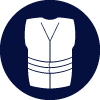
Metal Profile Sheets Metal 17 04 05
The metal profile sheet is a strong lightweight product made from flat coated steel that is molded into a range of trapezoidal/box, tile or corrugated profile shapes. These are base coated, galvanised and then top coated with polyester paint, PVC plastisol or other finish in a wide range of colours to resist corrosion. Barge, fascia, corner and ridge boards are made in the same way. They are all malleable to suit most architectural designs.
Usage & Probable Locations
Metal profile sheets and associated boards are used for roofing and side cladding of buildings, structures and portal frames. They are also used to clad the outside of large sliding doors of agricultural, industrial and retail buildings and occasionally for fence sheets. The sheets and boards are usually located on the outside of buildings and associated structures.
Personal Protective Equipment
PPE requirements indicated are for guidance purposes only. DRIDS has identified the PPE that is mandatory on all demolition projects and ones that may be required subject to site specific Risk Assessment & Method Statement (RAMS). Hover over the icon to determine the types of PPE required for the removal of this material.
Removal, Segregation & Storage
Metal profile sheets that are destined for reuse should be deconstructed, segregated and stored carefully and safely. Roof sheets should be stored flat on a suitably sized pallet or in bundles to prevent creasing. They should also be stored away from plant movements to prevent damage. Metal profile sheets destined for recycling should be segregated into metal recycling skips. There is little need to store metal profile sheets inside a building or under cover as they are robust against inclement weather.
Tools
Fixtures, Fittings & Connections
Metal profile sheets are usually fixed in place with drive nails, hook bolts, nuts and bolts and power driven screws. Rivets may be used to partially fix barge, fascia, corner and ridge boards. Metal profile sheets and boards around window and door frames will be fixed in place with screws, nails and rivets. Foam profile strips may also be used under ridge board edges and metal profile sheets along the wall plate to prevent drafts and stop birds and insects entering the buildings. Fibreglass or clear plastic profile sheets may also be used to allow natural daylight into the building.
Health & Safety
Subject to task-specific Risk Assessment & Method Statement (RAMS). Use correct protective equipment for removing drive screws, nails, bolts and rivets. Wear gloves when handling metal sheets with sharp edges or coated in paint to prevent irritation, cuts and metal splinters. Wear eye protection when using abrasive cutting tools and electric hand tools. Do not walk on wet and slippery sheets. Use appropriate access equipment as determined by RAMS. Only use cutting tools, 360 plant and attachments if properly trained.










